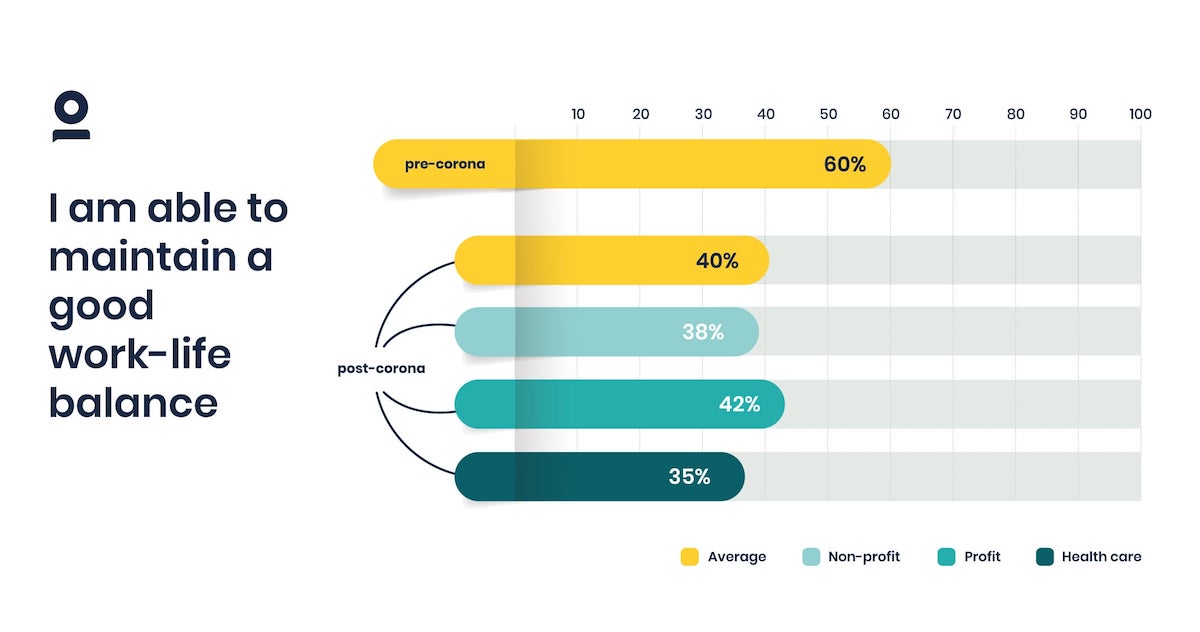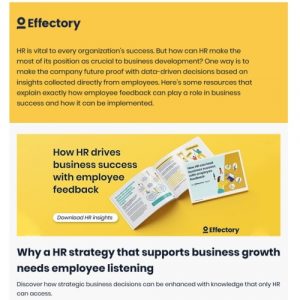The two main concerns at executive and board level are currently: How can we survive as an organization? And secondly: How do we prevent employees from burning out? Not all top managers see the relationship between these two concerns.
Working hard is only possible in a good, positive atmosphere

But focusing on people during this period is the key to future success. What you need now more than ever is employees who want to continue adding value to the organization and who have the vision to see the new opportunities that this situation presents. Motivated employees who want to engage positively with the company’s mission really make the difference between success and failure at the moment.
Despondency
Effectory analyses indicate that the risk of burning out is currently high. The current situation can leave employees exhausted, because working remotely means they lack human contact and no longer feel a proper part of the organizational culture. On top of that, they can experience a great deal of uncertainty about their roles, because they no longer know exactly what their own role is and what that of their teammates is.
Under these circumstances, they can feel they are under performing, precisely because work and private life are so intertwined. It can also be tempting to simply carry on working, including in the evening. In addition, some employees have a difficult home situation or are worried about family members. On top of this, many people are wondering when this whole situation will finally be over. They can experience tremendous feelings of hopelessness and despondency.
Receive the best HR articles in your mailbox
Subscribe to our newsletter and you will receive the best HR articles on a quarterly basis.
Sign upFive causes of burn-out
Burn-out is caused by a chronic mismatch between employees and their working environment in one or more areas (see box). In practice, personal overload—such as separation, money problems, bereavement or relocation—often acts as the specific trigger for burn-out. Although employers cannot influence this type of factor, of course, they can help their employees work on their resilience. It is also interesting that actually working much only has a small impact on the creation of burn-out.
- Workload: when employees have a long to-do list, are unclear on their role and/or lack skills or capacity.
- Autonomy: when employees do not have sufficient resources, information or decision-making powers to do their job properly.
- Reward: when employees receive too little financial reward, feel that their hard work is being ignored or is not appreciated, or when they do not feel proud of the work they do.
- Working atmosphere: when employees lose positive contact with their colleagues. What is most damaging to the working environment is a chronic conflict or bad relationship with a direct colleague.
- Sense of fairness: when there is inequality between employees, for example, in terms of pay or workload.
Source: Maslach & Leiter, 1997
Prompt escalation
This winter, it’s important to discover promptly who is really struggling. This could be employees who have small homes, have a busy home situation or are simply at risk of being lonely. You may be able to prioritize giving these people a place in the office and, as an HR department, you can make regular contact to ask how things are going.
You can also encourage teams to keep an eye on each other, or set up a buddy system. In addition, you also want to make it clear to everyone who they can turn to if they really can’t handle things anymore. This could be the HR department, for example, but also a confidential advisor.
Checklist: 5 tips for Reboarding Employees
Are your employees still working at home or at the office again? Or a combination of both? We are happy to share practical tips for reboarding employees.
DownloadA healthy organizational culture is a prerequisite for healthy employees
Employees can only endure difficult times such as these in the long term if they set time aside to recover properly and have sufficient energy resources at their disposal. As an employer, you can create the conditions for this, including remotely. The most important foundation for of the vitality of employees is a healthy organizational culture.
Organizations that continue to panic and spout meaningless statements about employees will be affected the most by weakening motivation and rising rates of absenteeism during this crisis. If management announces that it is planning to lay off thousands of people, for example, without saying who is involved, then that is completely the wrong approach and will create great psychological insecurity and increase the risk of burn-out.
Clear priorities
You can also try to increase employees’ energy resources by providing sufficient autonomy and to create an organizational culture where employees feel heard and appreciated. On top of that, you want to encourage employees to plan enough time for themselves. Clarity on roles is also an important key to preventing burn-outs: if you make sure that people are more aware of what to prioritize, they are less likely to end up in a demotivating work situation, freeze or even in a dangerous overdrive. All these factors together can mean the difference between never switching off and actually standing still occasionally.
Engagement in your work
In a series of ten blogs, Guido Heezen, founder of Effectory, explains the conditions required to create an engaged workforce. Engagement is the extent to which employees revel in their work. Engaged employees learn quickly and are creative. Engagement is a good predictor for customer satisfaction, low employee turnover, high productivity and profitability.
Book a free demo. See our solutions in action.
Effectory is Europe’s Leading provider of Employee Listening Solutions. Schedule a product demo and discover how to enhance your employees’ engagement.
Demo request


